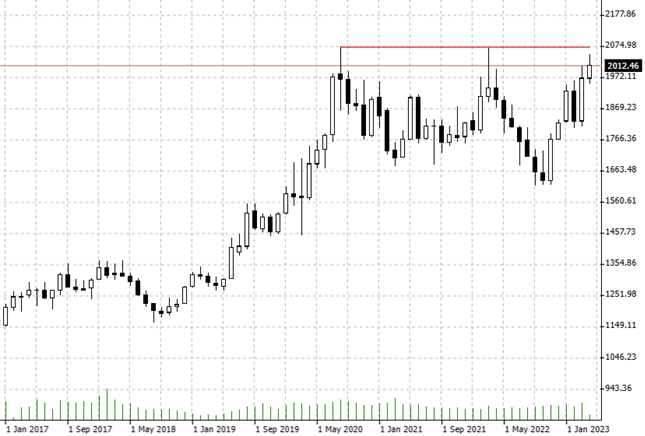

17.04.2023 – Is it coming or not, the new record? In recent days, the yellow metal has set its sights on the all-time high. Most recently, however, it has retreated somewhat. Now the new attempt to storm the summit is interesting from a chart-technical point of view.
Will gold make the breakthrough? Or is the resistance – see the red line – from the previous highs too strong and the price resets sustainably? Gold recently traded just below the all-time high from the summer of 2020. In the course of the Corona crisis, an ounce had cost $2,069 on the spot market at that time. Should gold form a triple top here and fail to make the run to the top, a setback would be likely from a chart perspective. We show the monthly chart, but the situation is also interesting for short-term traders.

Source: Bernstein Bank GmbH
The gold price was recently pulled up by two factors: on the one hand, the yellow metal became a safe haven again. The US banking crisis with the fear of many investors of a global bank run created new demand. Many people preferred to withdraw their savings from their accounts in order to buy coins or bars. Otherwise, there are enough crises: In addition to the war in Ukraine, there is the threat of an invasion of Taiwan. This could have severe consequences for world trade, as the Strait of Formosa and the entire maritime region around Taiwan would become impassable. And, incidentally, could mean World War III.
Come to stay
And then there would be inflation. Gold is traditionally a store of value – when the purchasing power of cash decays, the yellow metal promises stability. Apparently, some investors assume that high inflation will persist in the West. In China and Russia anyway, rising prices are part of monetary policy there. The Chinese know this and like to buy gold – anyone who has ever been to the Middle Kingdom will be amazed at the large jewelers selling all kinds of more or less kitschy figurines made of gold. For example, the withdrawal of material from the Shanghai Gold Exchange in February was 169 tons, up 76 tons year-on-year – mainly wholesalers had ordered. This was the strongest sale for the wholesale market since 2014. Overall, China imported about 1,343 tons of gold in 2022, the highest level since 2018.
But governments in the West also appreciate the benefits of inflation. As there are: higher tax revenues and the elegant repayment of government debt. In other words: collecting loans with hard currency today and paying them back with soft currency in a few years. So it’s no wonder that central banks around the world were among the big buyers last year. And so, according to the World Gold Council, total gold demand in 2022 rose 18 percent to 4,741 metric tons from the previous year.
Our conclusion from all this: If crises and inflation remain with us, there is a lot to be said for gold on the long side. If, of course, a major central bank thinks that the gold rally is over and just throws a few tons on the market, it will quickly go down again. Also keep an eye on the chart technique. Bernstein Bank keeps an eye on the matter for you!
_________________________________________________________________________
The content of this publication is for general information purposes only. In this context, it is neither an individual investment recommendation or advice nor an offer to purchase or sell securities or other financial products. The content in question and all the information contained therein do not in any way replace individual investor- or investment-oriented advice. No reliable forecast or indication for the future is possible with respect to any presentation or information on the present or past performance of the relevant underlying assets. All information and data presented in this publication are based on reliable sources. However, Bernstein Bank does not guarantee that the information and data contained in this publication is up-to-date, correct and complete. Securities traded on the financial markets are subject to price fluctuations. A contract for difference (CFD) is also a financial instrument with leverage effect. Against this backdrop, CFD trading involves a high risk up to the point of total loss and may not be suitable for all investors. Therefore, make sure that you have fully understood all the correlating risks. If necessary, ask for independent advice. CFDs are complex instruments and are associated with the high risk of losing money quickly because of the leverage effect. 68% of retail investor accounts lose money trading CFD with this provider. You should consider whether you understand how CFD work and whether you can afford to take the high risk of losing your money.7
